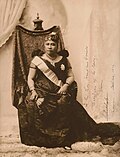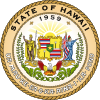The Hawaii Portal Hawaii (/həˈwaɪ.i/ ⓘ hə-WY-ee; Hawaiian: Hawaiʻi [həˈvɐjʔi, həˈwɐjʔi]) is an island state of the United States, in the Pacific Ocean about 2,000 miles (3,200 km) southwest of the U.S. mainland. One of the two non-contiguous U.S. states (alongside Alaska), it is the only state not on the North American mainland, the only state that is an archipelago, and the only state in the tropics. Hawaii consists of 137 volcanic islands that comprise almost the entire Hawaiian archipelago (the exception, which is outside the state, is Midway Atoll). Spanning 1,500 miles (2,400 km), the state is physiographically and ethnologically part of the Polynesian subregion of Oceania. Hawaii's ocean coastline is consequently the fourth-longest in the U.S., at about 750 miles (1,210 km). The eight main islands, from northwest to southeast, are Niʻihau, Kauaʻi, Oʻahu, Molokaʻi, Lānaʻi, Kahoʻolawe, Maui, and Hawaiʻi, after which the state is named; the latter is often called the "Big Island" or "Hawaii Island" to avoid confusion with the state or archipelago. The uninhabited Northwestern Hawaiian Islands make up most of the Papahānaumokuākea Marine National Monument, the largest protected area in the U.S. and the fourth-largest in the world. Of the 50 U.S. states, Hawaii is the fourth-smallest in land area and the 11th-least populous; but with 1.4 million residents, it ranks 13th in population density. Two-thirds of Hawaii residents live on O'ahu, home to the state's capital and largest city, Honolulu. Hawaii is one of the most demographically diverse U.S. states, owing to its central location in the Pacific and over two centuries of migration. As one of only seven majority-minority states, it has the only Asian American plurality, the largest Buddhist community, and largest proportion of multiracial people in the U.S. Consequently, Hawaii is a unique melting pot of North American and East Asian cultures, in addition to its indigenous Hawaiian heritage. Settled by Polynesians sometime between 1000 and 1200 CE, Hawaii was home to numerous independent chiefdoms. In 1778, British explorer James Cook was the first known non-Polynesian to arrive at the archipelago; early British influence is reflected in the state flag, which bears a Union Jack. An influx of European and American explorers, traders, and whalers soon arrived, leading to the decimation of the once-isolated indigenous community through the introduction of diseases such as syphilis, tuberculosis, smallpox, and measles; the native Hawaiian population declined from between 300,000 and one million to less than 40,000 by 1890. Hawaii became a unified, internationally recognized kingdom in 1810, remaining independent until American and European businessmen overthrew the monarchy in 1893; this led to annexation by the U.S. in 1898. As a strategically valuable U.S. territory, Hawaii was attacked by Japan on December 7, 1941, which brought it global and historical significance, and contributed to America's entry into World War II. Hawaii is the most recent state to join the union, on August 21, 1959. In 1993, the U.S. government formally apologized for its role in the overthrow of Hawaii's government, which had spurred the Hawaiian sovereignty movement and has led to ongoing efforts to obtain redress for the indigenous population. (Full article...) This is a Featured article, which represents some of the best content on English Wikipedia..
 The Hawaii Sesquicentennial half dollar was struck in 1928 by the United States Bureau of the Mint in honor of the 150th anniversary of Captain James Cook's landing in Hawaii, the first European to reach there. The coin depicts Captain Cook on the obverse and a Hawaiian chieftain on the reverse. Only 10,000 were struck for the public, making the coin rare and valuable. In 1927, the legislature of the Territory of Hawaii passed a resolution calling on the U.S. government to produce a commemorative coin for the 150th anniversary of Cook's arrival in Hawaii. Treasury Secretary Andrew Mellon thought the occasion important enough that, unusually for him, he did not oppose such an issue. The bill for the Hawaii half dollar passed through Congress without opposition or amendment, and became the Act of March 7, 1928 with the signature of President Calvin Coolidge. (Full article...)
This is a Good article, an article that meets a core set of high editorial standards.
The pilot episode of the reimagined crime series Hawaii Five-0 premiered on CBS in the United States on September 20, 2010. The pilot's teleplay was written by Peter M. Lenkov, based on a story developed by Lenkov, Alex Kurtzman and Roberto Orci, and was directed by Len Wiseman. The episode introduces the four main characters: Alex O'Loughlin as series protagonist and Navy SEAL, Lt. Commander Steve McGarrett, Scott Caan as Steve's partner Danny Williams, a former Detective from New Jersey who moved to Hawaii to be close to his daughter, Grace, Daniel Dae Kim as Chin Ho Kelly, a disgraced HPD cop and Grace Park as Kono Kalakaua, a former surfer-turned-HPD Academy graduate who is also Chin's cousin. In the pilot, McGarrett returns to Hawaii to find Victor Hesse (James Marsters), a terrorist who murdered his father, John McGarrett. The Governor of Hawaii, Pat Jameson (Jean Smart) offers McGarrett to head a new task force to fight serious crimes by any means. Since the end of the original Hawaii Five-O series, there had been a number of attempts to create a remake, but ultimately none went beyond the pilot stage. CBS later hired Lenkov to pitch a pilot story. Kurtzman and Orci were approached; while originally hesitant to participate in the project, they were impressed with Lenkov's pitch. The episode was filmed in March 2010 and took over two weeks to shoot. When the episode became too long certain sequences were cut from the final product, including the funeral scene with Taryn Manning as McGarrett's sister; the character would be introduced in a later episode. Almost 14.2 million Americans viewed the pilot, increasing to 17.59 million when Live+7-day digital video recordings (DVR) are taken into account, and was also considered a ratings success in other countries. Critical reactions were generally positive. (Full article...) Selected Picture - 'Ōlelo (Language) -This section is here to highlight some of the most common words of the Hawaiian Language, ʻŌlelo, that are used in everyday conversation amongst locals.
Kupuna
Elder State Facts
State Symbols:
Selected article -The Bernice Pauahi Bishop Museum, designated the Hawaiʻi State Museum of Natural and Cultural History, is a museum of history and science in the historic Kalihi district of Honolulu on the Hawaiian island of Oʻahu. Founded in 1889, it is the largest museum in Hawaiʻi and has the world's largest collection of Polynesian cultural artifacts and natural history specimens. Besides the comprehensive exhibits of Hawaiian cultural material, the museum's total holding of natural history specimens exceeds 24 million, of which the entomological collection alone represents more than 13.5 million specimens (making it the third-largest insect collection in the United States). The Index Herbariorum code assigned to Herbarium Pacificum of this museum is BISH and this abbreviation is used when citing housed herbarium specimens. The museum complex is home to the Richard T. Mamiya Science Adventure Center. (Full article...) Did you know? -
Hawaii News
Wikinews Hawaii portal
Quotes - "The people to whom your fathers told of the living God, and taught to call 'Father,' and whom the sons now seek to despoil and destroy, are crying aloud to Him in their time of trouble; and He will keep His promise, and will listen to the voices of His Hawaiian children lamenting for their homes." — Queen Liliʻuokalani On this day...There are no anniversaries listed for this day. Related portalsTopicsCategoriesAssociated WikimediaThe following Wikimedia Foundation sister projects provide more on this subject:
SourcesDiscover Wikipedia using portals |
























